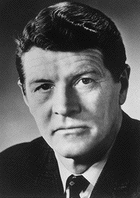Biol/Chem 5310
Lecture:10
September 25, 2001
Protein Folding
Protein denaturation is the reverse of protein
folding. It can be observed by changing from normal conditions
to conditions that favor the unfolding direction.
Examples:
Others:
Stabilizers: glycerol, sulfate ion
Destabilizers: guanidinium, urea
Protein folding is highly cooperative
As conditions are changed, e.g. temperature, the transition
from folded to unfolded occurs over a narrow range.
Intermediate states are seldom detected.
After the first noncovalent bonds are broken, the rest are
easier.
Denaturants will lower the Tm, melting temperature.
Quaternary Structure
Many proteins are complexes of multiple polypeptide chains. the spatial arrangement of these polypeptides is called the "quaternary structure". See animation of Fig. 6-33
These subunits may be identical or different. They are often indicated by letters or numbers
Hemoglobin
a2b2
2 types of subunits: a and b
2 copies of each
Proteins with identical subunits are called oligomers.
Such identical subunits are called protomers.
Hemoglobin could be called a dimer with an ab
protomer
In practice it is called a tetramer because it has 4 subunits
Oligomers generally have internal symmetry
This is always rotational symmetry, C2, C3, ...
Some proteins have dihedral symmetry, with 2 additional axes
of 2-fold rotational symmetry perpendicular to an axis of 2 (D2),
3(D3), or higher order.
Because amino acids are L-form, symmetry cannot be inversion
or mirror plane symmetry.
Subunit interactions include the same noncovalent interactions
that occur within proteins. (Electrostatic, h-bonds, van der
waals)
But they tend to be more hydrophobic.
They also include disulfide bonds
Dynamics of protein folding
Early experiments indicated that proteins fold spontaneously,
in an isolated form (i.e. without other proteins or other factors)
This suggested that the information for the 3-dimensional
structure of a protein must be contained in its amino acid sequence.
These experiments were carried out by Christian Anfinsen.
 (See link)
& also
Ribonuclease A: 124 amino acids, 4 disulfide bonds
(See link)
& also
Ribonuclease A: 124 amino acids, 4 disulfide bonds
1) Denature isolated protein in 8M urea
2) Reduce disulfide bonds using 2-mercaptoethanol: S-S ->
-SH
3a) Renature slowly by slowly diluting the urea, in the presence
of oxygen, pH 8.0
Disulfides form rapidly, randomly, enzyme activity is about
1%
OR
3b) Renature slowly in the presence of 2-mercaptoethanol, allowing
exchange between S-S and SH bonds
- Disulfides form correctly, enzyme activity is about 100%
Conclusion, under the right conditions, proteins can fold correctly
to the native structure.
Probability of 4 disulfides forming correctly in a random process
is:
1/7 x 1/5 x 1/3 = 1/105 = about 1 %
Other proteins such as insulin cannot be refolded correctly,
because of covalent modification. Such modification after folding
and disulfide formation can mean that the protein after further
modification is no longer in the state of lowest free energy.
Folding Accessory Proteins
In recent years 3 groups of proteins have been discovered
that aid in the folding of proteins in vivo.
1) Protein disulfide isomerase (PDI) See Animation of Fig. 6-39
shuffles disulfide and sulfhydryls in proteins
2) Peptidyl Proline isomerase
catalyzes the isomerization of the X-Pro peptide bond between
cis and trans
3) Protein Chaperones
A large class including several families of proteins that
assist in folding other proteins
Many have ATP hydrolysis activity
They are thought to bind to unfolded (hydrophobic) regions
of proteins, preventing inappropriate interactions between proteins
Proteins are then released and allowed to try folding properly
Example Hsp60
Mouse Control
Protein Dynamics
- Proteins are not static structures. Motions include:
- Atomic fluctuations
- Collective motions, of groups of atoms
- Conformational changes, with two or more stable conformations.
See Calmodulin link
- Mouse Control
Last updated Tuesday, September 25, 2001
Comments/questions: svik@mail.smu.edu
Copyright 2001, Steven B. Vik, Southern Methodist University
 (See link)
& also
(See link)
& also
 (See link)
& also
(See link)
& also